

Remote Work Survival Kit. HR and employment law — NCVO Knowhow. Information and guidance on recruiting and retaining staff, and managing performance.
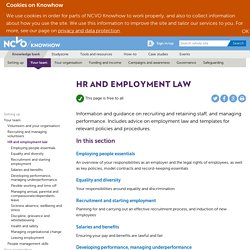
Includes advice on employment law and templates for relevant policies and procedures. In this section Employing people essentials An overview of your responsibilities as an employer and the legal rights of employees, as well as key policies, model contracts and record-keeping essentials. NCVO Knowhow. New Populo HR Home - Populo HR. ROOTS HR - human resources services for the social sector. Agenda Consulting.
Charities HR Network - Welcome. Working in Charity HR. Posted on 23/10/2018 by Bita Heffernan What is HR?

The human resources department of an organisation looks after the people who make up its workforce. HR covers many different employment functions, including compliance with employment law, pay and benefits, recruitment and training, employee relations and health and safety. Working for a charity is very similar to working in the private sector, in terms of the tasks you are likely to undertake. The main difference is that a charity’s employees usually choose to work for that organisation, as they feel a connection to its aims and values. Responsibilities for HR jobs HR professionals cover a wide variety of different tasks. Typical areas of work include: Employee relations This involves setting policies for working conditions, equal opportunities, grievances etc that balance the needs of your employees and the needs of your organisation.
In some charities, HR is also responsible for the management of volunteers as well as paid staff. HR Resources. From Conflict to Co-operation. The From Conflict to Co-operation series aims to help co-operatives not only to deal with conflict when it arises but also to avoid unnecessary conflict.
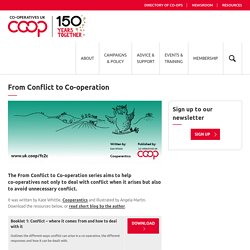
It was written by Kate Whittle, Cooperantics and illustrated by Angela Martin. Download the resources below, or read short blog by the author. The booklets are aimed primarily at flat democratically-managed co-operatives, small or large. However, they will be useful for any groups working democratically. Whilst it’s true that good governance will help co-operatives avoid many of the conflicts which can arise when a group of people work together, it’s also important to think about how we behave within the systems and processes of governance, using co-operative skills to improve communication, meetings and decision-making. From Conflict to Co-operation was written by Kate Whittle, Cooperantics, illustrated by Angela Martin and publised by Co-operatives UK.
Blog: Managing conflict in worker co-ops. Conflict is part of everyday life but despite this we don’t always know how to deal with it effectively.
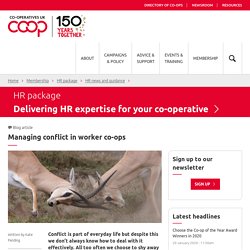
All too often we choose to shy away from conflict, choosing to avoid issues rather than dealing with them head on. Unfortunately this can mean that issues fester under the surface, becoming a much bigger problem than they might otherwise have been. In worker co-ops in particular, knowing how to deal with conflict effectively can be hard; without the ‘security’ of a traditional hierarchy members can find it difficult to raise issues or concerns with colleagues.
However, as a worker co-op you may find that you have a greater opportunity to be flexible in your approach, working with each other to find the process that best fits the culture of your organisation. It’s a big topic and we don’t claim to have all the answers. Traditional conflict resolution: disciplinary and grievance procedures Everyone will be familiar with the concept of disciplinary and grievance procedures. Employee health and well-being. Employers have a fundamental duty of care for the physical and mental health and well-being of their workers.
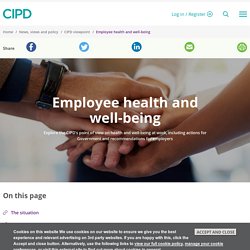
However, our research shows that only around half of organisations have employee well-being on their senior leaders’ agendas. A focus on employee health and well-being should be a core element of any HR strategy, and central to the way an organisation operates and fulfils its mission. It should not simply consist of one-off initiatives. As well as benefiting employees, an integrated approach to well-being can increase employee engagement, fostering a joint commitment to organisational success. In line with wider evidence, our research shows that the main risks to employee health are now psychological, with mental ill-health and stress being the top two causes of long-term absences. Supporting Mental Health at Work. This revised mental health guide for managers was jointly developed by mental health charity Mind and the CIPD to improve support for those experiencing stress and mental ill health issues.
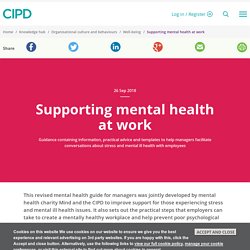
It also sets out the practical steps that employers can take to create a mentally healthy workplace and help prevent poor psychological well-being in the first place. This guidance, People managers’ guide to mental health, contains information, practical advice and templates to help managers facilitate conversations about stress and mental ill health. The aim is to put in place support so employees can stay well and in work – meaning they perform at their best for the business while the employer retains talent and expertise.
We first produced the guide in 2011 but have reviewed and updated it for 2018 in line with developments in both employment and how organisations manage mental health at work.